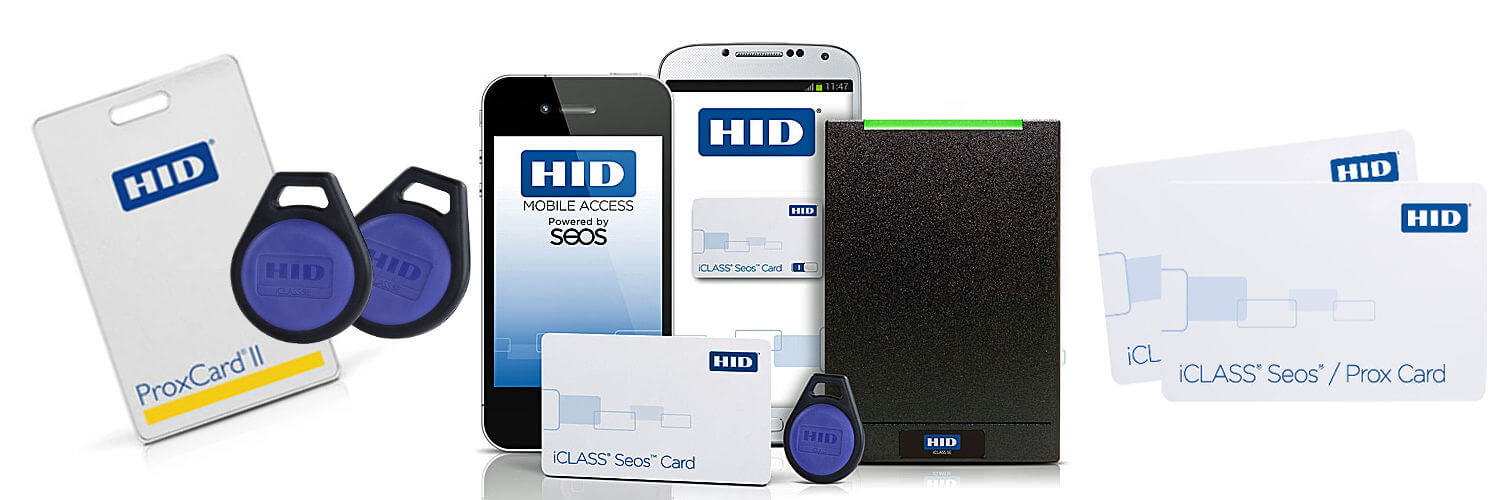RFID credentials include Proximity, HID iclass and Seos contactless smart cards, which are all popular technologies for supporting existing access control security systems. Many organizations issue ID badges, electronic key fobs, or blank PVC cards with programmed credentials to track and authorize custom access for employees, third parties, visitors, and other personnel.
It’s important to understand the specific type of RFID technology your organization uses as each facility requires a specific format.
125 kHz Low-Frequency Legacy RFID, Prox II, Proximity, ISO Prox & Clamshell Prox:
Low frequency RFID prox cards, tags and adhesive disks are often considered legacy credentials since newer, more secure technologies have come out. Despite the insufficient security of low frequency prox, millions of these credentials are still in use because of their long lasting durability, battery life, and low cost. These qualities make prox cards a popular choice for organizations to purchase as an ongoing consumable to support their physical access control system, even if it was installed more than 20 years ago.
We provide RFID cards to organizations of all sizes, across all industries using factory programmed credentials that typically ship out in less than a week.
Click here to view our selection of prox cards
If you are uncertain which type of card matches your system, feel free to contact us for guidance. You can also request a custom programmed sample of our most popular RFID card so you can test it on your system to verify it works!
Many organizations don’t realize that there is no encryption technology on the low frequency prox chips. This wasn’t as important back when these systems were first installed but nowadays this makes it easy for credentials to be duplicated. Consequently, access control systems are much more vulnerable to breaches.
Fortunately, the path to upgrading those isn’t difficult. It simply requires upgrading the readers and cards so that your system no longer relies on the unsecure technology. In most cases, however, other access control upgrades are often needed to meet new compliance requirements.
Newer and more secure solutions typically leverage encrypted high frequency credentials. These provide greater capability with cloud-based management, and can integrate with multiple applications. For any access control installation where security is a critical factor, it is essential to use encrypted technology for RFID.
Let’s look at some of the high frequency, smart chip credentials options below:
13.56 MHz High-Frequency RFID with HID Contactless Smart Cards, iClass, SEOS:
HID iClass Seos supersedes legacy and existing credential technologies by providing these key benefits:
- Highly advanced encryption and a software-based infrastructure
- Unrivaled data and privacy protection that can be used for applications beyond access control
- Cutting edge capabilities include dual-identity and mobile credentials.
- Best-in-class cryptography compared to other credential technologies
- Mobility: Seos is software-based and independent of the underlying hardware chip, providing new levels of form factor flexibility, including use on mobile devices, smart cards, tags, and more.
- Vertical Applications: Seos can be used to create bespoke solutions across numerous sectors including education, hospitality and government agencies.
Best of all, Seos access control cards can specify other technologies such as MIFARE and DESFire, as well as HID legacy ranges such as Prox and older iCLASS cards.
HID iCLASS SE
Although iClass SE doesn’t offer the same flexibility and security as Seos, iCLASS SE credentials can be considered a more powerful option than standard iCLASS due to a higher data storage capability.
- It also gets an SIO (Security Identity Object). This makes the card less vulnerable than other 13.56MHz technologies.
- Can be read from a distance of up to five meters depending on the environment
- iCLASS SE can be combined with older technologies such as MIFARE Classic.
These additions increase encryption and make the cards more secure, than other legacy options. This is a useful product for larger businesses that require increased security, that may not need all of the capabilities of SEOS.
_______
The beauty of HID reader technology is that you can specify the latest iCLASS cards to include older Proximity technology which supports a smooth upgrade to securer technology. For some organizations this comes in the form of dual tech or multi technology credentials with prox, iClass, and Seos, all in a single card (https://idsupershop.com/product/hid-iclass-seos-prox-dual-technology-contactless-smart-card-blank-glossy-pvc-printable_7/) .
Check out our in-depth blog on the PROs and CONS of RFID credentials here
Many organizations are surprised to find out that upgrading your legacy proximity badges to encrypted RFID doesn’t even cost more on a per card basis. With SEOS, you have the option of extending your credentials to Mobile ID which means the same ID number from a physical card to your smartphone. This suits businesses that operate in a hybrid work environment where employers need to secure network resources for remote workers and as well their onsite workforce.
Speak with an ID Solutions Expert today to build a roadmap or request a quote for the upgrades you should consider for readers, scanners, or credential keys based on your organization’s unique security needs.








Thank you for sharing this information. Very helpful and informative for choosing you as our new vendor